How to use a multimeter: we take measurements. A detailed description of how to use the multimeter correctly.
A multimeter is also often referred to as a "multi-tester" because it is designed to take a fairly wide range of indicators: measuring DC and AC voltage, resistance and current. Many multimeters also have the ability to measure the gain of transistors and have a special mode for testing diodes, continuity for a short circuit, etc. In a word - "multi" (for many) "tester".
Expensive models like measuring devices include additional functions: temperature measurement (using a thermocouple probe), coil inductance, capacitor capacitance.
We will learn how to use a multimeter using the example of a budget Chinese-made device worth $ 10-15 "XL830L", which I use.
Its delivery set includes a set of simple "probes" (red and black wires in the photo above), with the help of which measurements are made. They, if necessary, can be replaced with better or more comfortable ones.
👉 Note: be ready to immediately fix the entry points of both wires into the hollow plastic holder tubes with something (adhesive tape, electrical tape). The fact is that the conductors in the tubes are not rigidly fixed and when turning and bending the "probe" they can easily come off (due to the extremely flimsy solder) near the base of the measuring tip.
Before you start using the multimeter in full, let's take a closer look at our digital tester.
In its upper part we see a seven-segment digital display that can display up to four digits (9999 is the maximum value). When the battery is discharged, a corresponding inscription appears on it: “bat”.
There are two buttons below the board. On the left is the “Hold” button - holding the readings of the last value (so as not to keep it in memory when copying to a notepad). And on the right - "Back Light" - the backlight of the screen in blue (when measured in poor lighting conditions). On the back of the multimeter case there is a folding leg-stand (for convenient placement of the tester on the table).
Eats digital multimeter 9 volt battery type "Krona". True, to get to it we will have to remove the rubber protective cover and the back cover of the tester.
Circled in red at the bottom is our battery, and at the top is a fuse, which (I hope) will protect our meter from failure in the event of an overload.
So, before you start using the multimeter, you must correctly connect the measuring "probes" to it. General principle here's the next one:
The black wire (it is called differently: common, com, common, ground) is a minus. We connect it to the corresponding socket of the multitester labeled "COM". Red - in the nest to the right of him, this is our "plus".
The remaining free socket on the left is for measurement direct current with a limit of up to 10 amperes (high currents) and - without a fuse, as evidenced by the warning inscription "unfused". So be careful - do not burn the device!
Also note the warning sign (red triangle). Under it is written: MAX 600V. This is the maximum allowable voltage measurement limit for this multimeter (600 Volts).
🚨 Warning! Remember the following rule: if the measured values of voltage (Volts) or current strength (Amperes) are not known in advance, then to prevent the multitester from failing, set its switch to the maximum possible measurement limit. And only after that (if the readings are too small or not accurate), switch the device to a limit below the current one.
Now, in fact, - how to use a multimeter and how to switch these very "limits"?
It is necessary to work with a multimeter using a circular switch with a pointing arrow. By default, it is set to the “OFF” position (the device is turned off). We can rotate the arrow in any direction and thus "tell" the multitester what exactly we want to measure or - with what maximum limit we will work.
There is one very important point here! Working with a digital multimeter, we are able to measure the values of both AC and DC current and voltage. Now in industry and everyday life, the overwhelming majority is used alternating current. It is he who "flows" through high-voltage lines of wires from generators of power plants to our homes, "lights" our lighting lamps and "feeds" various household electrical appliances.
Alternating current, compared to direct current, is much easier to convert (using transformers) into a current of a different (we need) voltage. For example: 10,000 volts can be easily converted into 220 and completely calmly directed to the needs of a residential building. Alternating current (compared to direct current) is also much easier to "extract" on an industrial scale and transmit it (with less loss) over long distances.
It is necessary to use a multimeter, given all of the above. Therefore, memorize the following abbreviations:
DCV = DC Voltage - (eng. Direct Current Voltage) - constant voltage
ACV = AC Voltage - (Eng. Alternating Current Voltage) - AC voltage
DCA - (eng. Direct Current Amperage) - current strength of direct voltage (in amperes)
ACA - (eng. Alternating Current Amperage) - current strength of alternating voltage (in amperes)
Now, - we can learn to use the multimeter further. Take a closer look at the dial of your meter and you will definitely see that it is divided strictly into two parts: one for measuring DC and the second for AC voltages.
See the two letters "DC" in the lower left corner in the photo above? This means that to the left (relative to the “OFF” position) we will work with a multimeter, measuring constant values of voltage and current. Accordingly, the right side of the multitester is responsible for measuring AC current.
Now I suggest you immediately consolidate the acquired knowledge in practice. Let's show an example of using a multimeter to measure the capacity of a conventional CR 2032 bios battery with a nominal value of 3.3 Volts. Remember our red warning? Always set the limit higher than the measured values. We know that the battery has 3.3V and this is a direct current. Accordingly, we set the "limit" of measurements on the DC scale to 20 Volts on the circular switch.
Pay attention to the red marked “+” sign on the battery. We apply a "plus" (red probe) to this side of it, and a "ground" (black) to the reverse side.
Note: if you mix up the polarity (to the plus - minus, and to the minus - plus), i.e. - swap "probes" in places - nothing bad will happen, just before the result on the digital display you will see a "minus" sign. The measurement values themselves will remain correct.
So, we used a multimeter and what is the result? Look (photo above) at the digital display of the tester. The numbers "1.42" are displayed there. So our battery now has 1.42 Volts (instead of the prescribed three). With a swing of it - into the trash can! The computer will automatically reset the BIOS settings with such a battery each time it is turned on.
In order to learn how to use a multimeter and work effectively with it, we need to know (remember, write down, memorize, tattoo) the following designations, which we will surely meet on similar meters, regardless of their model.
More advanced models of multimeters also show the capacitance of the elements - "F" (it is measured in Farads) and the inductance - "L" (calculated in Henry - "H").
The next switch position is 600 volts on the AC scale. It is the best suited for measuring the voltage in a household electrical network (the current is alternating and the scale value is several times higher than the required one - 220 V.).
The order of the "probes" in the outlet does not matter.
The next position is 200 Volts (you don’t need to measure the voltage in the outlet on it - the multimeter will burn out!). To the right we have the number "200" with the sign "µ" (microampere - one millionth of an ampere). Similar values of quantities can be used in various kinds of electrical circuits.
The next on the scale is "2m" (two milliamps - two thousandths of an ampere). The indicator is found mainly in transistors. Further - "200m" - similarly, but the countdown starts from two hundred milliamps. The next switch position is "10A" ( maximum strength current - ten amperes). This is a territory of high currents, be careful! Here we will need to include the red "probe" into a special socket, indicated in the photo as "10ADC".
Acoustic wave (continuity) line icon for a short circuit. What use is this to us? Let's take a look at an example.
Imagine such a situation (as it turned out - very real) that some of the cables were forgotten to be signed. It turns out the following: on the other wing of the building (near the user's computer socket), we cannot tell which cable out of a hundred this particular ending belongs to, and the search for a "happy ending" automatically turns into a separate task
This is where the mode of using the multitester as a "dialer" of the cable for a short circuit will come to our rescue. Since there is a hint in the name itself, we are left with the following - to organize this very short circuit (short circuit).
In low-voltage networks (which include computer LANs), this is not at all scary. At the ends of the cables on both sides, we remove the protective coating, select one specific cable (which we want to find (ring out)) and also clear any pair of its conductors from insulation. And then - just twist them together, creating a "loop" in the line. By God, it's faster to show in the photo than to describe in words.
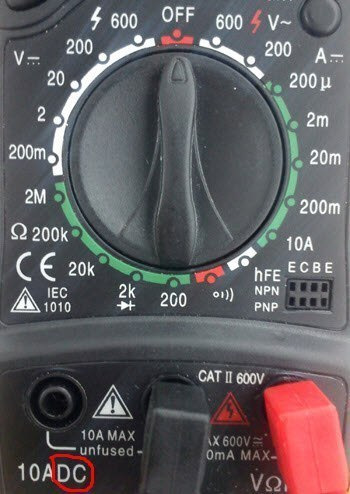

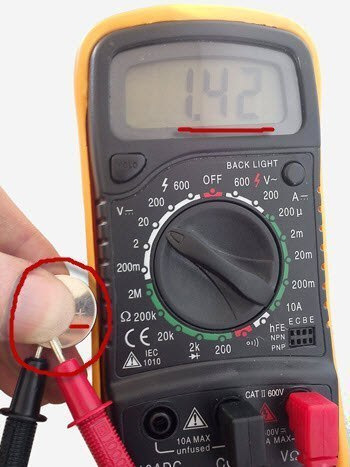

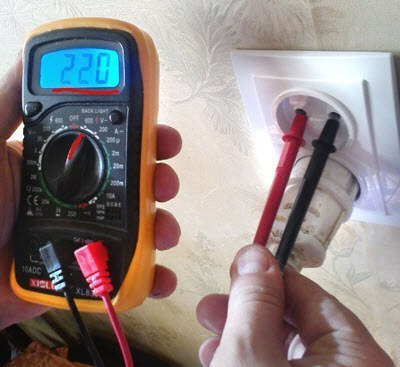
Follow author
In this article, we will talk about the functions of modernmultimeters. We will not go into details, since the goal is to familiarize only with the main functions of the device. Let's get started.
Currently, there is a huge variety of multimeters (testers), they are mainly pointer or electronic device. The price can vary from 200 to 5000 rubles, of course, the more expensive the device, the more functions and more accurate it is.
multimetercapable of measuring resistance, temperature, direct current and voltage, alternating current and voltage, capacitance and other quantities. As you can see, the set of functions is large, hence the prefix “multi”, that is, many, many devices in one. Let's get to know appearance device and see what's what. As an example, take a simple DT 700D
 So, we have a simple electronic multimeter, it is a device with a digital dial and a mode switch, and it also has a transistor socket and three probe connectors. Moreover, when the multimeter is working, only two connectors are used, com is used constantly, and 10ADC and VΩ
mAare selected depending on the required measurement limits. The probes that come with the kit are usually red and black, functionally, they are exactly the same, the color is for convenience.
So, we have a simple electronic multimeter, it is a device with a digital dial and a mode switch, and it also has a transistor socket and three probe connectors. Moreover, when the multimeter is working, only two connectors are used, com is used constantly, and 10ADC and VΩ
mAare selected depending on the required measurement limits. The probes that come with the kit are usually red and black, functionally, they are exactly the same, the color is for convenience.
10ADC- the connector is designed to measure large currents, in this case up to 10 A.
VΩmA - connector for measuring all kinds of voltages and currents up to 20 mA.
Com- common, usually a black probe is inserted into this connector.
Off– “off” position
ACV– alternative current voltage. The AC voltage measurement mode has two measurement limits - 200 V and 750 V.
DCA– direct current amperage. Mode for measuring direct current, has limits of 2000 μA, 20 mA, 200 mA, 10 A. It is important to remember that when measuring currents from 200 mA, you need to move the red probe from the V socket Ω mA to the 10ADC socket, otherwise it may blow the fuse inside the instrument.
hFE– mode for measuring the transistor current gain.
- sound generator mode, designed for troubleshooting in audio frequency amplifiers. Often on many multimeters, instead of this mode, there is a temperature measurement mode.
- dialing mode, allows you to check the integrity of the conductor.
Ω – resistance measurement mode, limits from 200 Ohm to 2000 kOhm.
DCV– direct current voltage. DC voltage measurement mode, measurement limits from 200 mV to 1000 V.
To measure DC voltage, we need to turn the switch to the DCV position. For example, we want to check the suitability of a finger-type battery, we know that the voltage at its poles is 1.5 V, so based on this we set the measurement limit to 2000 mV. Such a limit will be the most suitable, because the lower the limit we set, the more accurate we will get the result, for example, if we set the next limit to 20 V, then most likely we would see a voltage not of 1.412 V, but only of 1.4 V
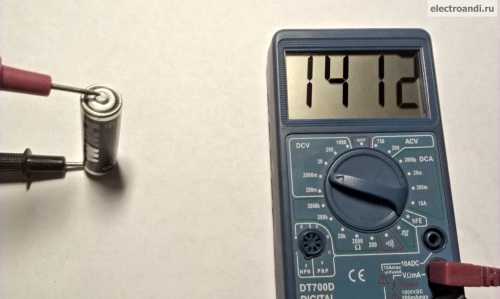
To measure the resistance, move the switch to the position Ω, i.e. ohmmeter mode. We will have a 220 kΩ resistor as an experimental element. Let's assume that we do not know its resistance (this is logical, because why measure it then) we will switch the switch to the limit of 2000 KΩ, the device will show us the value of 219 KΩ. Do not be surprised that it is not 220, firstly the multimeter is the simplest (and therefore not the most accurate), and secondly, a lot depends on how tightly the probes fit to the resistor terminals. If the resistor were nominal, for example, 100 kOhm, then we would transfer to the limit of 200 kOhm for greater accuracy.
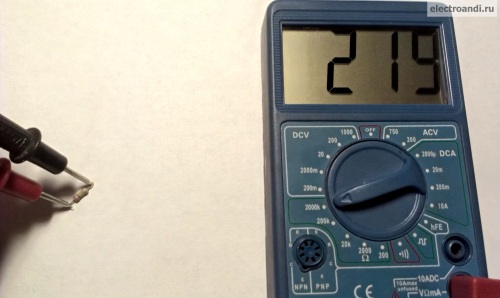
To measure AC voltage, you need to turn the switch of the multimeter to the ACV position. For example, we want to measure the voltage in a home socket, we know that it is about 220 V, so the 200 V limit is not enough for us, and we will set it to 750 V. Be careful when measuring voltages of this magnitude! It is best if you refrain from such experiments.
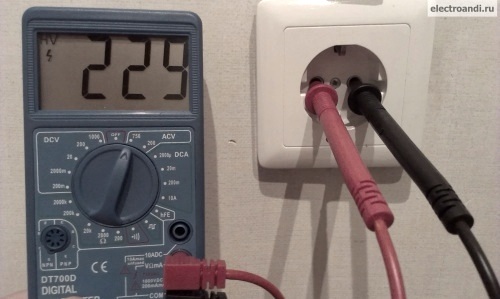 Current measurement
Current measurement
To measure current, you need to move to the DCA position. Moreover, in our case, the multimeter is capable of measuring only direct current, more expensive devices can also measure alternating currents. To measure the current, you need to know approximately its value, if it is more than 200 mA, be sure to rearrange the red probe to the 10ADC socket. It is better not to measure large currents with such a device, or measure it, but very quickly, since the device is likely to fail.
To measure the current, you need to connect the multimeter in series with the load, for example, a light bulb.
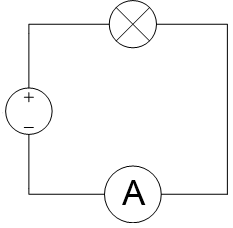 In the role of an ammeter, our multimeter.
In the role of an ammeter, our multimeter.
Be careful when measuring currents! Follow the safety rules!
dialing
The continuity mode is simple, in order to find out if the conductor is intact, you need to switch the multimeter switch to the continuity position, and touch the ends of the conductor with the probes, while if the conductor is intact, the multimeter will make a characteristic call, if not, then as you understand nothing will happen.
And finally.
Remember using a multimeter:
1 – Do not touch the probes with your hands, this leads to their contamination, and as a result to measurement inaccuracies.
2 – If the device shows one, then the measurement limit is small for a given value, you need to switch to a larger one.
3 – Carefully check in which sockets the probes are located.
4 – Think over your actions, do not allow haste, this can lead to disastrous consequences
5 - After the end of the measurements, move the switch to the Off position, or if it is not there, then to the position with the greatest resistance.
That's all! Be careful when working with electricity and good luck!
A multimeter is a measuring device with which you can check the integrity of the electrical conductor, measure the voltage in the outlet. Here our site decided to tell you how to use a multimeter.
People who are ignorant reasonably have questions: why do I need a multimeter, how to use a multimeter? In this article, we will also explain how to measure with a multimeter.
Types and device of the multimeter
There are analog and digital multimeters.

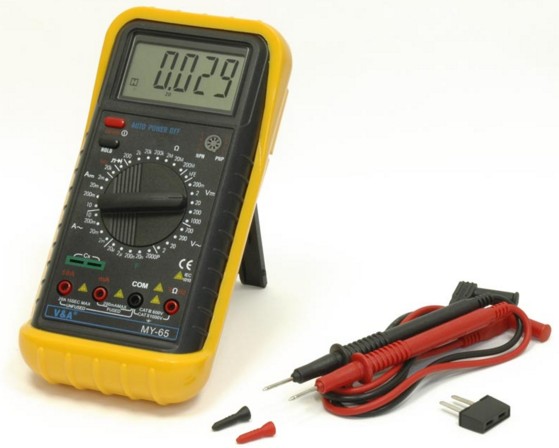
The results of measurements in a digital multimeter appear on the LCD screen as digital values. This simplifies the use of the device, avoids errors when taking readings, which makes digital multimeters the most used.
Regardless of the model, any multimeter provides voltage, current and resistance measurements. The controls in all multimeters are also located in the same way. On the body of the device in the center there is a multi-position rotary switch, which allows you to set the measured parameters and their limits. Each parameter with its limits is delimited by lines.
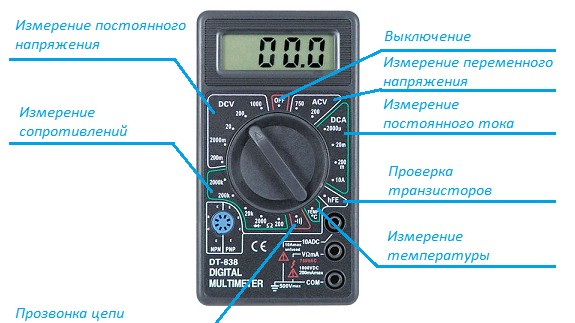
In addition to the multi-position switch, any multimeter has a display or a measuring scale - in analog multimeters. Also, the device has sockets for connecting probes.
Using the DT-830B DIGITAL brand multimeter as an example, consider the controls. Measurement parameters are set by turning the switch to one or another position:
- OFF - off;
- ACV - alternating voltage;
- DCV - direct voltage;
- ACA - alternating current (this parameter is absent in the model under consideration);
- DCA - direct current;
- Ω is resistance;
- hFE - transistors.
Probe connection
The probe consists of a metal rod with an insulated handle and a wire for connecting to a multimeter.
If the probes are out of order, you can make them yourself by buying the necessary parts on the radio market. You can also make probes with crocodile clip-on tips and a long wire. has similar probes.

At the bottom of the multimeter case there are sockets for connecting probes. Negative (common or grounded - depends on the measured parameter), the socket is marked with a grounding symbol and the letters COM. The black wire is usually connected to this jack. To measure resistance, voltage, current up to 200mA, a socket with the inscription VΩmA is used. To measure the current strength within 200mA-10A, there is a socket designated as 10A or 10 ADC.
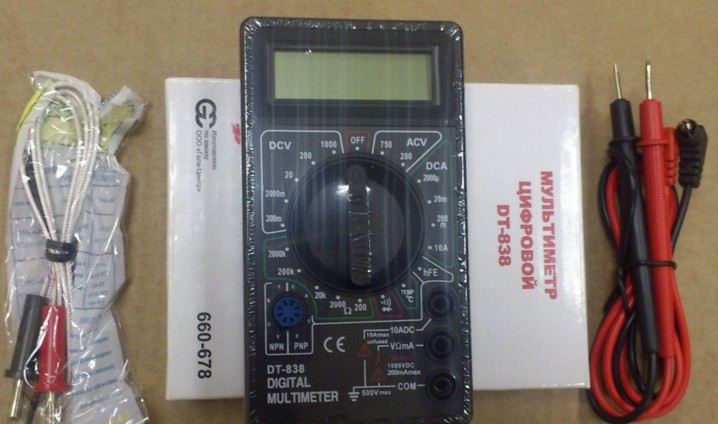
Using the M-831 digital device as an example, we will consider the question of how to use a multimeter.
Using the M-831 device, you can measure DC and AC voltage up to 600 Volts, set the value of DC up to 10 Amperes and electrical resistance up to 2 mega ohms.
How to use a multimeter when measuring DC voltage
To measure DC voltage in the multimeter, there is a certain range of values that are set using the limit switch. The limit is chosen depending on the voltage value that we want to measure.
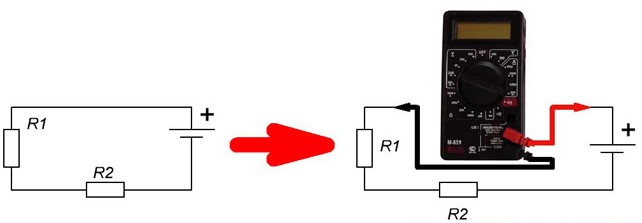
For example, you need to measure the DC voltage on the battery of a video camera. Having studied on the display, we establish that its voltage is 7.4 volts. On the multimeter, set the measurement limit close to this value. In this case, we set 20 volts. When measuring voltage in electrical circuits, the limit is set higher than the supply voltage of the circuit, otherwise the multimeter may break. Then the black probe connected to the multimeter's COM jack is connected to the battery minus, the red probe connected to the multimeter's VΩmA jack is connected to the battery plus. The DC voltage value will appear on the display.
If you do not know the approximate value of the measured voltage, then the maximum limit is set on the multimeter (for M-831 - 600 Volts). Then gradually it is necessary to reduce the limit to the value closest to the measured voltage value.
How to use a multimeter when measuring AC voltage
AC voltage is measured in the same way as DC voltage. The switch is set to measure AC voltage to the selected limit. Then the probes are connected to an AC voltage source. The results appear on the LCD screen.
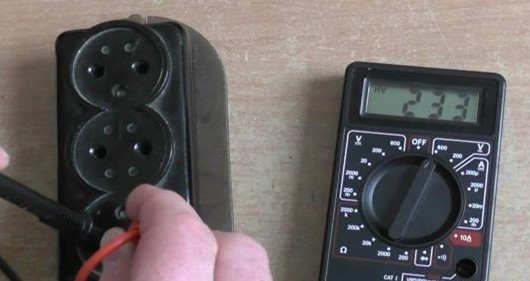
How to use a multimeter when measuring DC current
Devices M-830, M-831 are designed to measure direct current only. To measure DC current, the multimeter is connected to an open circuit.
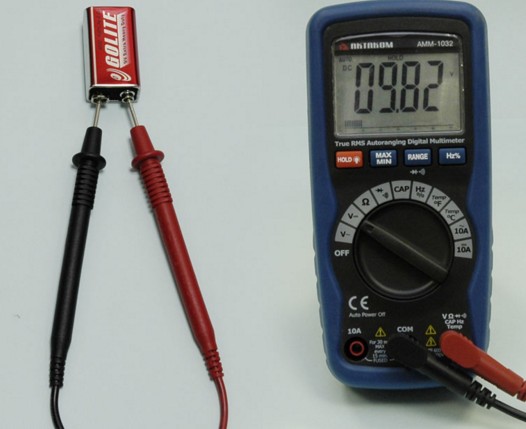
We set the switch to direct current mode to the maximum possible current value in the measured circuit. When measuring a current value less than 200mA, the corresponding limit is set, while the red probe is connected to the VΩmA jack and the multimeter is turned on in the open circuit.
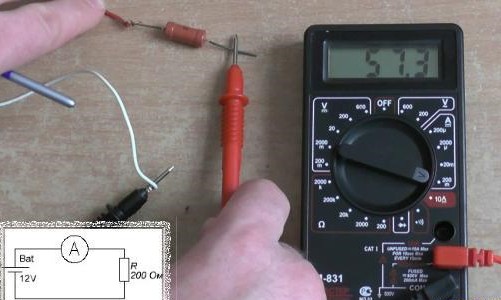
If the current value is measured in the range of 200mA - 10A, the red probe is connected to the 10A socket.

When working in the current measurement mode, the multimeter is connected to the circuit when the voltage is off, otherwise it is unsafe to take measurements, especially at the limit of 10A.
In addition, in some models of multimeters, when measuring current at a limit of 10A, it is not recommended to turn on the device for more than 15 seconds.
How to use a multimeter when measuring resistance
To measure the resistance, the switch is set to the appropriate mode for one of the five measurement limits.
The limit is chosen as follows:
In the case when the value of the measured resistance is known in advance, the limit is selected, the value of which is greater, but as close as possible to the value of the measured resistance. Then the measurement error will be minimal. If you decide to perform, then you can not do without this device.

In the case when the value of the measured resistance is not known in advance, the maximum possible measurement limit for this model of the multimeter is set (for M-831 - 2000 kOhm). Then, decreasing the limits, they gradually approach the measured resistance value.
The appearance of the number "1" on the screen indicates that the set limit is less than the value of the measured resistance. In this case, the limit must be increased.
The probes of the multimeter are connected to the element whose resistance is measured. Appropriate indications appear on the screen. As you can see, measuring with a multimeter is a fairly simple process that anyone can perform.
A multimeter is a universal portable device designed to measure various electrical (electronic) quantities. The multimeter is able to replace several devices, because. with it, you can measure voltage, current, resistance, etc.
For example, the functionality of some multimeters additionally allows you to measure temperature, check transistors, semiconductors, etc. Many models of multimeters have a function to automatically turn off the display when the device is not active, and there is also a backlight function.
As portable measuring instruments, multimeters have long been used both in production and in everyday life.
Modern multimeters are produced in two types: analog and digital. When using an analog multimeter, the measured value is determined by the position of the arrow on the scale of the device. For digital multimeters, the measured value is displayed on the liquid crystal display in the form of numbers.
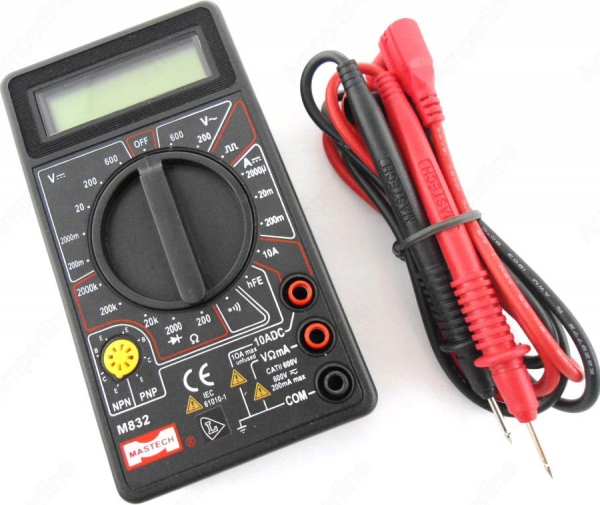
In practice, digital multimeters are used more often than analog ones. The main reason is the high measurement accuracy and convenience in displaying the measured value. But analog instruments also has its advantages.
To use the multimeter correctly, you need to know its basic structure and basic operating modes. Multimeters of different models may differ in size, appearance and the number of measured values, but the main functionality is the same for all.
The simplicity of the device, basic functionality and additional modes are demonstrated by the DT-831 digital multimeter.
The device and equipment of the multimeter DT-831
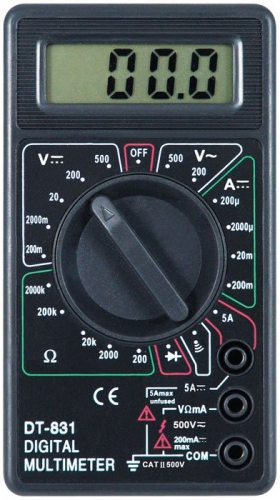
At the top of the front panel is digital display, in the center there is a multi-position switch for measurement modes, and in the lower part there are three sockets for measuring probes.
When purchasing a multimeter, it will not be superfluous to know what is included in the package. Each product, including the DT-831, comes with two measuring probes, one 9V krone battery, one user manual and a packing box.
Multimeter functionality
Regardless of the type and type, any multimeter allows you to measure the main electrical quantities. This also applies to the DT-831 model.
- AC voltage measurement is performed in ACV (alternating current voltage) mode.
- DC voltage measurement is performed in DCV (direct current voltage) mode.
- DC current measurement is performed in DCA (direct current amps) mode.
- Electrical resistance is measured in Ω mode.
For measurements, in addition to the main modes, additional ones are also used. For example, the image of a semiconductor is a diode test mode. Sound image - mode of continuity of circuits by a buzzer.
The instrument is turned off by setting the multi-position switch to OFF.
Before measurements, the black probe is connected to the common socket marked COM (common), and the red measuring probe to the VΩmA socket. Sometimes it is necessary to measure a direct current value of more than 200mA. In this case, the red measuring probe must be connected to the "10A" socket.
How to use the DT-831 multimeter for dummies - Video
AC voltage measurement
In domestic conditions, most often the voltage is measured in sockets, in junction boxes, in switchboards, in metering boards. The standard value of this voltage is about 220V. In production, alternating voltage is measured in switchgear, power cabinets, protection devices, etc. If in a household network the voltage is usually single-phase, then in production there is both a single-phase voltage of 220V and a three-phase voltage of 380V.
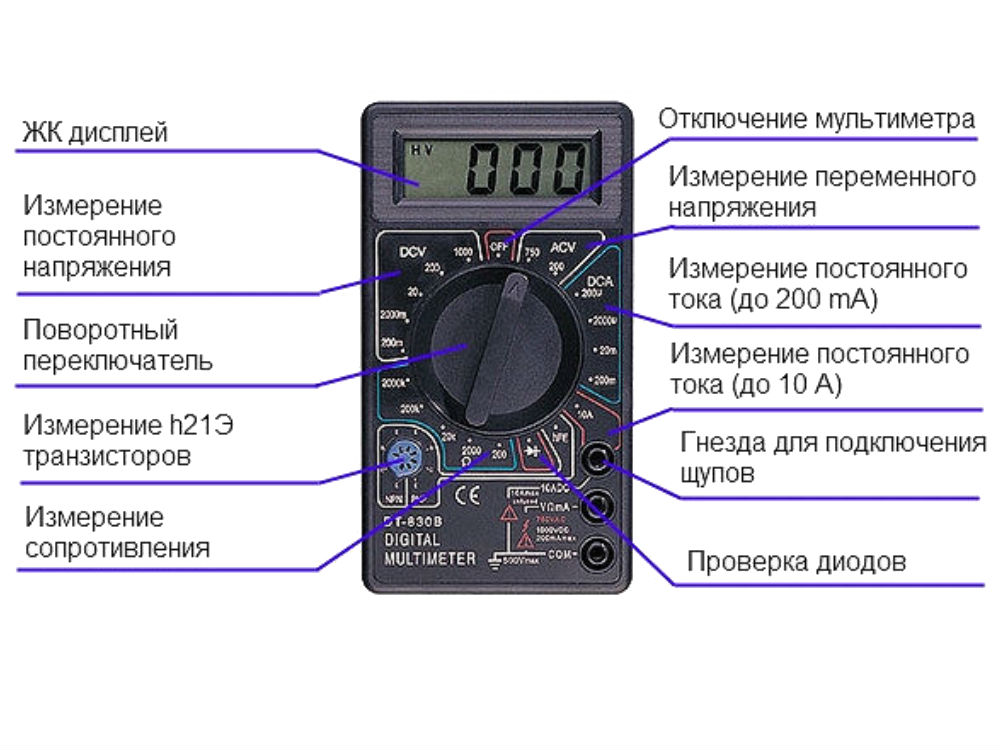
The first measurement is made as follows. The multi-position switch is set to the maximum limit. The DT-831 multimeter has 750V. After that, in fact, the measurement is performed by parallel connection multimeter to the measured element or section of the circuit. For example, the phase voltage is measured relative to zero (phase voltage), or between two phases of a three-phase network (linear voltage).
If the voltage value (and another value in a different measurement mode) is significantly less than the maximum limit (for example, 150V), then for greater accuracy, the multi-position switch switches to a lower limit. In ACV mode it will be 200V limit.
DC voltage measurement
At home, measuring direct voltage is reduced to measuring the voltage of conventional batteries, car batteries, power supplies from household appliances. In production, DC voltage sources are rectifiers, DC generators, etc.
Measuring DC voltage is not much different from measuring AC voltage. The only difference is that the measurement in DCV mode is between plus and minus. In addition to direct voltage measurement, DCV mode allows you to determine the polarity in DC circuits.
If the voltage value is known in advance before the measurement (for example, a finger-type battery 1.5V), then the multi-position switch can be immediately set to the nearest limit (20V).
DC current measurement
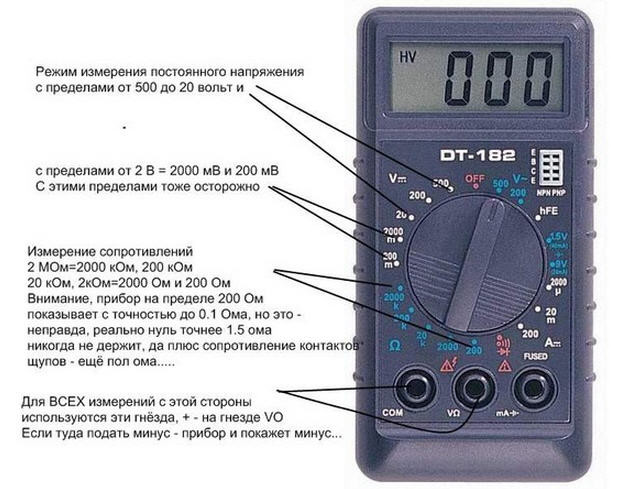
This measurement is performed in DCA mode. A multimeter, like an ammeter, is connected in series to an open circuit. It is advisable to imagine the current value in advance in order to set the appropriate measurement limit.
How to measure resistance with a multimeter
In any model of the multimeter there is a function for measuring resistance. In the Ω mode, you can measure the resistance of resistors, the value of the electrical insulation resistance of wires, etc. Often in the Ω mode, electrical circuits are tested.
The DT-831 multimeter has five resistance measurement limits, ranging from 200 ohms to 2000 kOhm (2MΩ). Resistance is measured by pre-selecting one of five limits.
If the measured value is greater than the set limit, then the display of the multimeter will display "1". In this case, it is enough to set the switch to a higher limit. If the display shows all zeros, then the actual resistance value is significantly less than the set limit and therefore the limit must be reduced.
It is only allowed to measure the resistance when the power is off in order to avoid damage to the multimeter.
The most common instrument for electrical measurements is multimeter, which allows you to determine not only the magnitude of the current and voltage, and also effectively ring the circuit for integrity, determine the value of its resistance. And besides, the multimeter will help radio amateurs to check transistors, diodes and other radio components, but we will not dwell on this in detail, but will dwell in great detail on those functions that relate directly to electrical measurements in the home electrical network and household electrical appliances.
As an example, I will take the most common Chinese multimeter model, which is inexpensive and can be bought almost everywhere. For rare use in the household, it will be enough, but for everyday use by professional electricians, it is not suitable due to low reliability and workmanship of materials.
Having studied the principles of work in our instructions with a multimeter, shown in the figure below, you can work with any other model, since the principles of operation are similar everywhere. Differences are found only in applied icons, types and limits of measurements and the presence of additional functions.
How to use a multimeter.
The tester works with two probes, the bare tips of which We will touch the contacts of sockets, switches, wires, etc. to obtain electrical measurements.
After connecting the probes, you must use the switch to set it to the desired position, corresponding to the type and limit of measurement. That's all it remains to make measurements, taking into account the difference in connecting the probes, depending on the type of measurements.
The multimeter model in the picture can measure the following parameters (listing clockwise, starting from the OFF position):
- ACV - AC voltage measurement function (2 positions 200 and 750 Volts). We set the maximum limit of 750 V for the home electrical network.
- DCA - Function for measuring the magnitude of DC current or Amps. It is not used in practice, because it is designed to determine small currents.
- hFE - Measurement of the transmission coefficient of the transistor (for radio amateurs).
- Rectangular pulse generator, the same for radio engineers.
- Continuity to determine the integrity of a circuit or wire. In this position, with the probes closed, an audible signal beeps and shows resistance in ohms if the circuit is closed.
- Function of measurement of resistance in 5 maximum limits: 200 Ohm, 2000 Ohm or 2 kOhm, 20 kOhm, 200 kOhm, 2000 kOhm or 2 mOhm. Most often in practice, two positions are used 2000 Ohm and 2000 kOhm.
- DCV - measurement of direct voltage within five maximum limits: 200 mV, 2000 mV or 2 V, 20 V, 200 V and 1000 V. For measuring the voltage of car batteries and various power supplies, I set 20 or 200 Volts.
Note: If there is a unit on the display of the device, the limit is not set correctly, if minus, swap the terminals, if the battery is dead in the multimeter.
How to test a multimeter.
- It is quite simple to check by connecting another multimeter or voltmeter in parallel with it to the outlet.
- To check the accuracy of resistance determination, take with the marking and the value of any resistance and compare with the readings of the device.
- To check the accuracy of current measurement. Take alternate measurements of the same load with your device and an ammeter.
How to call with a multimeter.
We put the switch in the dialing mode, and close the probes - the device should beep and the readings should be displayed: either zero, or a little higher. The sound indicator only beeps up to 80 ohms. After that, we check on both sides for integrity wiring diagram and its connections. In more detail I will describe how this is done correctly in a separate article.
How to measure with a multimeter.

How to measure current with a multimeter.
This model allows you to measure up to a maximum of 10 Amps. To determine the current consumption, connect a multimeter in series to a household appliance, as shown in the picture.
Most often it is done like this: the device is connected to the break of one phase wire going to the measured consumer.
Attention, if a separate terminal is provided for measuring current strength above 200 mA, do not forget to rearrange the probe in the appropriate place.
How to measure voltage with a multimeter.
In a home electrical outlet, a multimeter can only measure alternating voltage with an upper limit of 700 volts. Power supplies and batteries must be measured with respect to the polarity in the DC voltage measurement mode, setting the upper limit with a margin.
How to test a battery with a multimeter.
I’ll tell you right away in order to effectively check car battery a special load plug is needed, which measures the voltage under load, otherwise you will not qualitatively determine the condition of the car battery.
For ordinary finger batteries to check the status, it is necessary to set the switch to the maximum limit for measuring direct current and literally close it with a wire for no more than half a second in order to have time to see the readings on the screen. Do not hold more than 0.5 sec. - this causes a breakdown or deterioration in the performance of the battery.
For 1-2 volt healthy batteries, the short circuit current must be at least 2 amperes. If it is less than 1 ampere, then you will have to buy a new one or use it for control panels for household appliances in the house.
How to measure resistance with a multimeter.
I want to say right away that you cannot measure the resistance either in the socket or in the battery. But for that you can easily recognize it from an electric light bulb or heating element of an electric kettle or heater, this is required to determine their integrity or performance.
Attention! Before measurement, disconnect all wires from the measured device! In this mode, devices under voltage cannot be measured!
Advice! You can even measure the resistance of your body, just take the multimeter probes in different hands. It is completely safe and will not harm your health.
Related content:




